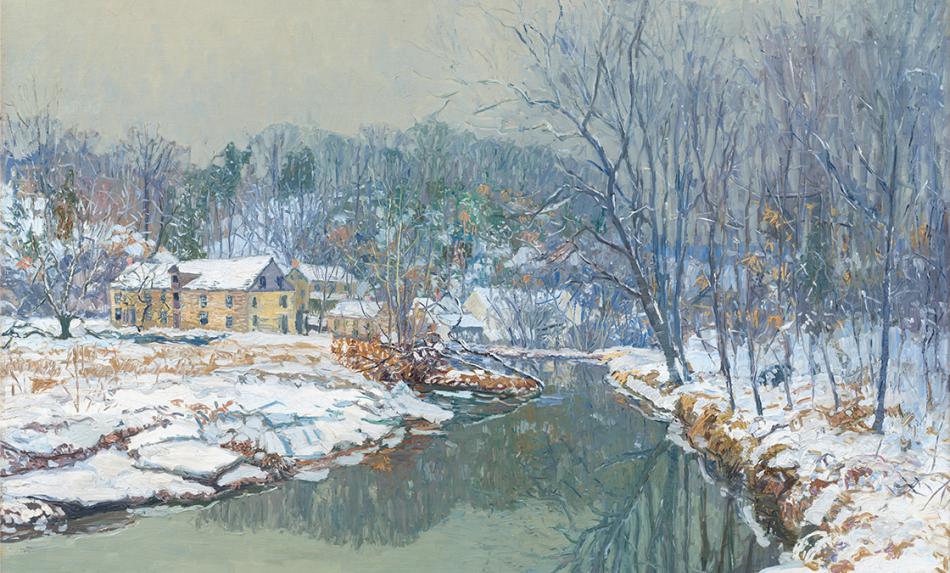Madison Square, Snow
1904
Allen Tucker
Painter, American, 1866 - 1939

Allen Tucker abandoned a career as an architect and became an artist in 1904. His early paintings such as Madison Square, Snow are indebted to the tonal impressionist style of his teacher at the Art Students League, John H. Twachtman. Representations of small urban parks seen from an elevated vantage point were popular among French impressionists such as
Located between Madison and Fifth Avenues and extending from 23rd to 26th Streets, Madison Square Park had become a major commercial and entertainment area. It was especially noted for Stanford White’s Madison Square Garden, a popular concert hall, amphitheater, and roof garden built in 1889. There were a number of other iconic modern structures in the area, such as Daniel H. Burnham’s famous Flatiron Building.
Tucker deliberately avoided any clearly recognizable view of Madison Square Park and its urban environs. Reflecting the growing influence of Robert Henri’s realism, his rendition instead emphasizes the dramatic encroachment of the city’s looming skyline on the park and is less anecdotal than the works of many of his impressionist contemporaries.
Artwork overview
-
Medium
oil on canvas
-
Credit Line
-
Dimensions
overall: 50.8 x 60.9 cm (20 x 24 in.)
framed: 66 x 76.2 cm (26 x 30 in.) -
Accession Number
1971.13.2
More About this Artwork

Video: Wintertime Art Screensaver
Enjoy relaxing music and a series of wintertime landscapes from the National Gallery of Art's collection.
Artwork history & notes
Provenance
The artist [1866-1939]; by inheritance to his wife, Mrs. Allen Tucker [d. 1944]; The Allen Tucker Memorial, New York;[1] gift 1971 to NGA.
[1] The Allen Tucker Memorial was established in 1944.
Associated Names
Exhibition History
1972
Extended loan for use by Secretary Peter G. Peterson, U.S. Department of Commerce, Washington, D.C., 1972-1973.
1975
Extended loan for use by the Ambassador, U.S. Embassy residence, Dublin, Ireland, 1975-1978.
1979
Extended loan for use by Secretary G. William Miller, U.S. Department of Treasury, Washington, D.C., 1979-1980.
1981
Extended loan for use by Secretary Donald T. Regan, U.S. Department of Treasury, Washington, D.C., 1981.
1983
Extended loan for use by Ambassador L. Paul Bremer, U.S. Embassy residence, The Hague, The Netherlands, 1983-1987.
1989
Extended loan for use by Secretary Louis Sullivan, U.S. Department of Health and Human Services, Washington, D.C., 1989-1993.
1995
Extended loan for use by Ambassador Jeonnone Walker, U.S. Embassy residence, Prague, 1995-1998.
2005
Extended loan for use by Secretary Margaret Spellings, U.S. Department of Education, Washington, D.C., 2005-2008.
Bibliography
1992
American Paintings: An Illustrated Catalogue. National Gallery of Art, Washington, 1992: 370, repro.
Inscriptions
lower left: A. Tucker / 04
Wikidata ID
Q20190895



